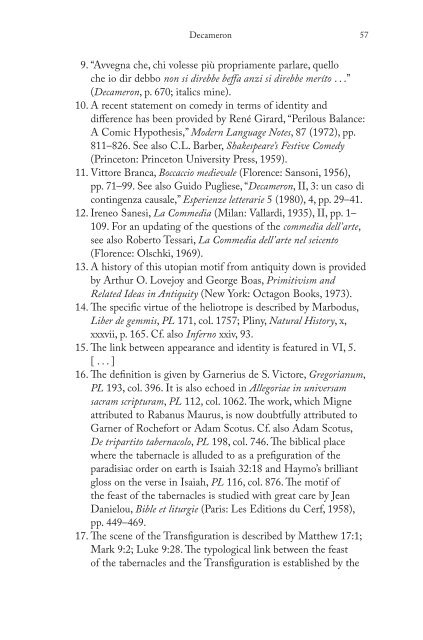Blooms Literary Themes - THE TRICKSTER.pdf - ymerleksi - home
Blooms Literary Themes - THE TRICKSTER.pdf - ymerleksi - home
Blooms Literary Themes - THE TRICKSTER.pdf - ymerleksi - home
Create successful ePaper yourself
Turn your PDF publications into a flip-book with our unique Google optimized e-Paper software.
Decameron 57<br />
9. “Avvegna che, chi volesse più propriamente parlare, quello<br />
che io dir debbo non si direbbe beff a anzi si direbbe meríto . . .”<br />
(Decameron, p. 670; italics mine).<br />
10. A recent statement on comedy in terms of identity and<br />
diff erence has been provided by René Girard, “Perilous Balance:<br />
A Comic Hypothesis,” Modern Language Notes, 87 (1972), pp.<br />
811–826. See also C.L. Barber, Shakespeare’s Festive Comedy<br />
(Princeton: Princeton University Press, 1959).<br />
11. Vittore Branca, Boccaccio medievale (Florence: Sansoni, 1956),<br />
pp. 71–99. See also Guido Pugliese, “Decameron, II, 3: un caso di<br />
contingenza causale,” Esperienze letterarie 5 (1980), 4, pp. 29–41.<br />
12. Ireneo Sanesi, La Commedia (Milan: Vallardi, 1935), II, pp. 1–<br />
109. For an updating of the questions of the commedia dell’arte,<br />
see also Roberto Tessari, La Commedia dell’arte nel seicento<br />
(Florence: Olschki, 1969).<br />
13. A history of this utopian motif from antiquity down is provided<br />
by Arthur O. Lovejoy and George Boas, Primitivism and<br />
Related Ideas in Antiquity (New York: Octagon Books, 1973).<br />
14. Th e specifi c virtue of the heliotrope is described by Marbodus,<br />
Liber de gemmis, PL 171, col. 1757; Pliny, Natural History, x,<br />
xxxvii, p. 165. Cf. also Inferno xxiv, 93.<br />
15. Th e link between appearance and identity is featured in VI, 5.<br />
[ . . . ]<br />
16. Th e defi nition is given by Garnerius de S. Victore, Gregorianum,<br />
PL 193, col. 396. It is also echoed in Allegoriae in universam<br />
sacram scripturam, PL 112, col. 1062. Th e work, which Migne<br />
attributed to Rabanus Maurus, is now doubtfully attributed to<br />
Garner of Rochefort or Adam Scotus. Cf. also Adam Scotus,<br />
De tripartito tabernacolo, PL 198, col. 746. Th e biblical place<br />
where the tabernacle is alluded to as a prefi guration of the<br />
paradisiac order on earth is Isaiah 32:18 and Haymo’s brilliant<br />
gloss on the verse in Isaiah, PL 116, col. 876. Th e motif of<br />
the feast of the tabernacles is studied with great care by Jean<br />
Danielou, Bible et liturgie (Paris: Les Editions du Cerf, 1958),<br />
pp. 449–469.<br />
17. Th e scene of the Transfi guration is described by Matthew 17:1;<br />
Mark 9:2; Luke 9:28. Th e typological link between the feast<br />
of the tabernacles and the Transfi guration is established by the

















